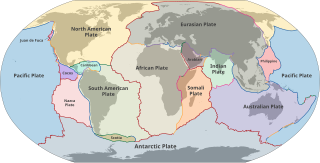
Earth is the third planet from the Sun and the only astronomical object known to harbor life. This is enabled by Earth being an ocean world, the only one in the Solar System sustaining liquid surface water. Almost all of Earth's water is contained in its global ocean, covering 70.8% of Earth's crust. The remaining 29.2% of Earth's crust is land, most of which is located in the form of continental landmasses within Earth's land hemisphere. Most of Earth's land is somewhat humid and covered by vegetation, while large sheets of ice at Earth's polar deserts retain more water than Earth's groundwater, lakes, rivers and atmospheric water combined. Earth's crust consists of slowly moving tectonic plates, which interact to produce mountain ranges, volcanoes, and earthquakes. Earth has a liquid outer core that generates a magnetosphere capable of deflecting most of the destructive solar winds and cosmic radiation.

Plate tectonics is the scientific theory that Earth's lithosphere comprises a number of large tectonic plates, which have been slowly moving since 3–4 billion years ago. The model builds on the concept of continental drift, an idea developed during the first decades of the 20th century. Plate tectonics came to be accepted by geoscientists after seafloor spreading was validated in the mid-to-late 1960s. The processes that result in plates and shape Earth's crust are called tectonics. Tectonic plates also occur in other planets and moons.

The Snowball Earth is a geohistorical hypothesis that proposes during one or more of Earth's icehouse climates, the planet's surface became nearly entirely frozen with no liquid oceanic or surface water exposed to the atmosphere. The most academically mentioned period of such a global ice age is believed to have occurred some time before 650 mya during the Cryogenian period, which included at least two large glacial periods, the Sturtian and Marinoan glaciations.
Charles Hutchins Hapgood was an American college professor and author who became one of the best known advocates of the pseudo-scientific claim of a rapid and recent pole shift with catastrophic results.

In astronomy, axial tilt, also known as obliquity, is the angle between an object's rotational axis and its orbital axis, which is the line perpendicular to its orbital plane; equivalently, it is the angle between its equatorial plane and orbital plane. It differs from orbital inclination.

Earth's magnetic field, also known as the geomagnetic field, is the magnetic field that extends from Earth's interior out into space, where it interacts with the solar wind, a stream of charged particles emanating from the Sun. The magnetic field is generated by electric currents due to the motion of convection currents of a mixture of molten iron and nickel in Earth's outer core: these convection currents are caused by heat escaping from the core, a natural process called a geodynamo.

Milankovitch cycles describe the collective effects of changes in the Earth's movements on its climate over thousands of years. The term was coined and named after the Serbian geophysicist and astronomer Milutin Milanković. In the 1920s, he hypothesized that variations in eccentricity, axial tilt, and precession combined to result in cyclical variations in the intra-annual and latitudinal distribution of solar radiation at the Earth's surface, and that this orbital forcing strongly influenced the Earth's climatic patterns.

Paleomagnetism is the study of prehistoric Earth's magnetic fields recorded in rocks, sediment, or archeological materials. Geophysicists who specialize in paleomagnetism are called paleomagnetists.

Polar motion of the Earth is the motion of the Earth's rotational axis relative to its crust. This is measured with respect to a reference frame in which the solid Earth is fixed. This variation is a few meters on the surface of the Earth.
A geomagnetic excursion, like a geomagnetic reversal, is a significant change in the Earth's magnetic field. Unlike reversals, an excursion is not a "permanent" re-orientation of the large-scale field, but rather represents a dramatic, typically a (geologically) short-lived change in field intensity, with a variation in pole orientation of up to 45° from the previous position.

Fingerprints of the Gods: The Evidence of Earth's Lost Civilization is a 1995 pseudoarcheology book by British writer Graham Hancock, which contends that an advanced civilization existed in prehistory, one which served as the common progenitor civilization to all subsequent known ancient historical ones. The author proposes that sometime around the end of the last ice age this civilization ended in cataclysm, but passed on to its inheritors profound knowledge of such things as astronomy, architecture and mathematics.

In astronomy, a polar is a highly magnetic type of cataclysmic variable (CV) binary star system, originally known as an AM Herculis star after the prototype member AM Herculis. Like other CVs, polars contain two stars: an accreting white dwarf (WD), and a low-mass donor star which is transferring mass to the WD as a result of the WD's gravitational pull, overflowing its Roche lobe. Polars are distinguished from other CVs by the presence of a very strong magnetic field in the WD. Typical magnetic field strengths of polar systems are 10 million to 80 million gauss. The WD in the polar AN Ursae Majoris has the strongest known magnetic field among cataclysmic variables, with a field strength of 230 million gauss.
The Einstein–de Haas effect is a physical phenomenon in which a change in the magnetic moment of a free body causes this body to rotate. The effect is a consequence of the conservation of angular momentum. It is strong enough to be observable in ferromagnetic materials. The experimental observation and accurate measurement of the effect demonstrated that the phenomenon of magnetization is caused by the alignment (polarization) of the angular momenta of the electrons in the material along the axis of magnetization. These measurements also allow the separation of the two contributions to the magnetization: that which is associated with the spin and with the orbital motion of the electrons. The effect also demonstrated the close relation between the notions of angular momentum in classical and in quantum physics.

True polar wander is a solid-body rotation of a planet or moon with respect to its spin axis, causing the geographic locations of the north and south poles to change, or "wander". Unless the body is totally rigid, its stable state rotation has the largest moment of inertia axis aligned with the spin axis, with the smaller two moments of inertia axes lying in the plane of the equator. If the body is not in this steady state, true polar wander will occur: the planet or moon will rotate as a rigid body to realign the largest moment of inertia axis with the spin axis.
Polar wander is the motion of a pole in relation to some reference frame. It can be used, for example, to measure the degree to which Earth's magnetic poles have been observed to move relative to the Earth's rotation axis. It is also possible to use continents as reference and observe the relative motion of the magnetic pole relative to the different continents; by doing so, the relative motion of those two continents to each other can be observed over geologic time as paleomagnetism.
Apparent polar wander (APW) is the perceived movement of the Earth's paleomagnetic poles relative to a continent while regarding the continent being studied as fixed in position. It is frequently displayed on the present latitude-longitude map as a path connecting the locations of geomagnetic poles, inferred at distinct times using paleomagnetic techniques.
Plate reconstruction is the process of reconstructing the positions of tectonic plates relative to each other or to other reference frames, such as the Earth's magnetic field or groups of hotspots, in the geological past. This helps determine the shape and make-up of ancient supercontinents and provides a basis for paleogeographic reconstructions.

The geomagnetic poles are antipodal points where the axis of a best-fitting dipole intersects the surface of Earth. This theoretical dipole is equivalent to a powerful bar magnet at the center of Earth, and comes closer than any other point dipole model to describing the magnetic field observed at Earth's surface. In contrast, the magnetic poles of the actual Earth are not antipodal; that is, the line on which they lie does not pass through Earth's center.

The HAB Theory is a 1976 science fiction novel by American author Allan W. Eckert. The novel is from the apocalyptic fiction subgenre. Eckert believed that the real-world facts and conclusions he quoted in the novel, were worthy of further exploration. One such conclusion was that hyper-specialization in the physical sciences was a big problem and that more interactions between hyper-specialists was overdue. He wove facts and concepts into the novel form, then his 17th book, to get more minds considering them. The book explores a version of pole shift hypothesis postulated by Professor Charles Hapgood in two volumes, plus the 1967 book Cataclysms of the Earth by Hugh Auchincloss Brown.
Rand Flem-Ath is a Canadian librarian and author known for his numerous books about the lost continent of Atlantis and the theory of Earth Crustal Displacement. His views are influenced by Charles Hapgood and in turn influenced Graham Hancock's Fingerprints of the Gods.












